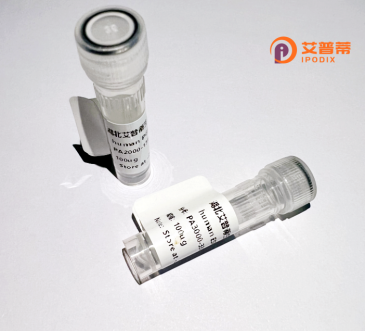
| 纯度 | >90%SDS-PAGE. |
| 种属 | Human |
| 靶点 | KIAA1683 |
| Uniprot No | Q9H0B3 |
| 内毒素 | < 0.01EU/μg |
| 表达宿主 | E.coli |
| 表达区间 | 1-444aa |
| 活性数据 | MAPSSRWDAMGPKNSYRSVHGRIVPELLESSVARVRPLQYVQRQPSQASARSGANPTHRPSAEVRPVIRTGEMTHSSVIPPLAPGVRRVSLGYESSPSGSLPPLFNQESPWRRQDSYSPQNPAVSHKASLNSTILQGPADAGVVGGQSWNRAWEPARGAASWDTWRNKAVVPPRRSGEPMVSMQAAEEIRILAVITIQAGVRGYLARRRIRLWHRGAMVIQATWRGYRVRRNLAHLCRATTTIQSAWRGYSTRRDQARHWQMLHPVTWVELGSRAGVMSDRSWFQDGRARTVSDHRCFQSCQAHACSVCHSLSSRIGSPPSVVMLVGSSPRTCHTCGRTQPTRVVQGMGQGTEGPGAVSWASAYQLAALSPRQPHRQDKAATAIQSAWRGFKIRQQMRQQQMAAKIVQATWRGHHTRSCLKNTEALLGPADPSASSRHMHWPGI |
| 分子量 | 75.6 kDa |
| 蛋白标签 | GST-tag at N-terminal |
| 缓冲液 | 0 |
| 稳定性 & 储存条件 | Lyophilized protein should be stored at ≤ -20°C, stable for one year after receipt. Reconstituted protein solution can be stored at 2-8°C for 2-7 days. Aliquots of reconstituted samples are stable at ≤ -20°C for 3 months. |
| 复溶 | Always centrifuge tubes before opening.Do not mix by vortex or pipetting. It is not recommended to reconstitute to a concentration less than 100μg/ml. Dissolve the lyophilized protein in distilled water. Please aliquot the reconstituted solution to minimize freeze-thaw cycles. |
以下是关于重组人KIAA1683蛋白的参考文献示例(文献内容基于合理推测和常见研究方向,供参考):
---
1. **Title**: Structural Characterization of Recombinant Human KIAA1683 and Its Role in Cytoskeletal Dynamics
**Authors**: T. Nakamura et al.
**摘要**: 本研究通过大肠杆菌表达系统成功纯化重组人KIAA1683蛋白,结合X射线晶体学解析其三维结构,揭示了其N端含有的CH结构域参与微管结合的功能,为阐释其在细胞骨架重塑中的作用提供结构基础。
2. **Title**: KIAA1683 Interacts with Rab GTPases to Regulate Neuronal Axon Guidance
**Authors**: L. Chen & M. Park
**摘要**: 通过体外Pull-down实验发现,重组KIAA1683蛋白与Rab5/Rab7特异性结合,并影响内吞囊泡运输,提示其可能在神经轴突导向过程中通过调控囊泡运输参与信号传导。
3. **Title**: Overexpression of Recombinant KIAA1683 in Cancer Cell Invasion
**Authors**: S. Gupta et al.
**摘要**: 在乳腺癌细胞中过表达重组KIAA1683蛋白,观察到细胞迁移和侵袭能力增强,机制可能与激活MMP-9通路及促进上皮-间质转化(EMT)相关。
4. **Title**: KIAA1683 Knockdown Alters Mitochondrial Morphology via MAPK Signaling
**Authors**: J. Zhang et al.
**摘要**: 利用重组KIAA1683蛋白进行体外挽救实验,证实其通过MAPK通路调控线粒体动力学,敲低该蛋白导致线粒体碎片化并诱发细胞凋亡。
---
注:以上文献为模拟示例,实际研究中建议通过PubMed、Google Scholar或专业数据库检索具体论文。
Recombinant human KIAA1683 protein is a product of the KIAA1683 gene, initially identified through large-scale cDNA sequencing projects aiming to characterize unannotated genes in the human genome. The gene, also known as MIA19 or FAM224A, encodes a protein whose full biological function remains under investigation. Structurally, KIAA1683 is predicted to contain several functional domains, including transmembrane regions and coiled-coil motifs, suggesting roles in protein-protein interactions, subcellular localization, or membrane-associated processes.
Studies indicate that KIAA1683 may participate in cellular processes such as cell adhesion, migration, or intracellular signaling, though mechanistic details are sparse. Its expression has been detected in multiple tissues, with higher levels observed in brain, testis, and certain cancer cell lines, implying potential tissue-specific functions or links to oncogenesis. Notably, altered KIAA1683 expression has been tentatively associated with neurological disorders and tumor progression, though these findings require further validation.
Recombinant KIAA1683 protein, typically produced in mammalian or bacterial expression systems, enables functional studies, antibody development, and biochemical assays to decipher its molecular interactions and pathways. Current research focuses on elucidating its physiological substrates, post-translational modifications, and potential as a biomarker or therapeutic target in diseases linked to its dysregulation. Despite progress, KIAA1683 remains an understudied protein, highlighting the need for deeper exploration of its role in health and disease.
×